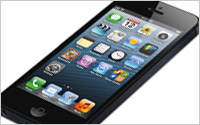Ad Execs See Opportunity In iPhone 5
- by Mark Walsh @markfwal, September 12, 2012
 The subject of endless speculation finally arrived Wednesday with the unveiling of the iPhone 5 at a ritual Apple event in San Francisco, led by CEO Tim
Cook. As expected, the company rolled out its signature device with a larger display, improved camera and 4G LTE networking all wrapped in a thinner body of aluminum and glass.
The subject of endless speculation finally arrived Wednesday with the unveiling of the iPhone 5 at a ritual Apple event in San Francisco, led by CEO Tim
Cook. As expected, the company rolled out its signature device with a larger display, improved camera and 4G LTE networking all wrapped in a thinner body of aluminum and glass.
Given the months of rumors and leaks ricocheting around the blogosphere leading up to today, there were few surprises left as to what the latest iPhone would offer.
There was no novel addition like Siri in the iPhone 4S or controversial new design feature like the external antenna. Still, digital ad executives and analysts expect the iPhone to lure new customers and provide a richer canvas for mobile campaigns and m-commerce.
Forrester analyst Charles Golvin noted that competitors like HTC and Nokia already offer some of the features Apple debuted Wednesday, like those for imaging. “But Apple still outpaces the competition when it comes to the entire package -- the new iPhone unites significant improvements in industrial design, imaging, audio and connectivity, along with the wealth of new capabilities that iOS6 enables,” he wrote in a blog post today.
Ad executives see promise with the iPhone 5's larger, 4-inch screen with Retina display, boasting 18% more pixels for delivering interactive campaigns. “176 extra pixels isn't exactly acreage, but it's just enough to make mobile ad creative a little more eye-catching and get users more deeply engaged. Mis-clicks will be less likely and actions a little easier to execute,” said Rachel Pasqua, vice president of mobile at digital agency iCrossing.
She added that the extra screen size will also be a bonus for landing pages and sites that campaigns link to, encouraging interaction.
Likewise, Anne Frisbie, managing director, North America for mobile ad network InMobi, sees the device enhancing brand advertising in mobile. “The iPhone5’s richer display and faster operating speed will allow brands to really take their offering to the next level and more deeply engage through mobile,” she said.
The faster delivery of mobile data via 4G could spur greater use of video in advertising with the knowledge that users are likely to have a better experience than with 3G networks. Combined with the better visual aspects of the iPhone 5, it could lead to increased use of apps, the mobile Web and other types of mobile media.
With the iPhone 5 and rollout of iOS 6, Apple is also introducing Passbook, the digital wallet service announced in June that allows users to store and sort loyalty cards, gift cards, virtual offers, ticketing and the like. Large retailers, including Starbucks, have already signed on to integrate Passbook into iOS apps. As executives see the potential to tap into the new service to expand m-commerce efforts.
“Passbook will offer brands the opportunity to be front and center with the consumers they are trying to reach. Imagine walking by a store and having a coupon for 20% off pop up -- a very powerful tool for marketers,” noted Alex Campbell, co-founder and chief innovation officer at mobile agency Vibes.
Others, however, expressed disappointment that the new iPhone did not incorporate near-field communication technology, which many expect to become the standard means of powering mobile transactions. Getting the iPhone on board would help accelerate that process. The absence of NFC “begs the question -- what is holding Apple back from the m-commerce and m-payments space that all the other big OEMs and software companies are sprinting toward?" said Patrick Moorhead, vice president, mobile sales at in-store and digital shopping marketer Catalina Marketing.
Unlike Samsung or other companies that may be embracing NFC, he said Apple “has the power to fundamentally create and shift markets.”
Among other iPhone 5updates (rumored or not) that marketers were hoping to see were an on-screen keyboard enhancement akin to Swype on Android, a Liquidmetal screen and the addition of T-Mobile USA as a carrier partner. (AT&T, Sprint and Verizon Wireless already sell the iPhone.)
Beyond the iPhone 5 itself, Apple also made the line more accessible by dropping the price of the subsidized 16 Gb iPhone 4S to $99, while making the 8 GB iPhone 4 free with a two-year contract. Kurt Hawks, general manager at mobile ad network Greystripe, said the move would simply lead to greater opportunity to reach consumers on smartphones.
A JP Morgan estimate projects Apple will sell some 45 million iPhones in the fourth quarter, with more than half being iPhone 5s.


